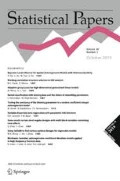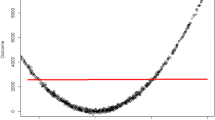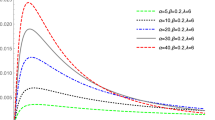Abstract
We study the properties of the called log-beta Weibull distribution defined by the logarithm of the beta Weibull random variable (Famoye et al. in J Stat Theory Appl 4:121–136, 2005; Lee et al. in J Mod Appl Stat Methods 6:173–186, 2007). An advantage of the new distribution is that it includes as special sub-models classical distributions reported in the lifetime literature. We obtain formal expressions for the moments, moment generating function, quantile function and mean deviations. We construct a regression model based on the new distribution to predict recurrence of prostate cancer for patients with clinically localized prostate cancer treated by open radical prostatectomy. It can be applied to censored data since it represents a parametric family of models that includes as special sub-models several widely-known regression models. The regression model was fitted to a data set of 1,324 eligible prostate cancer patients. We can predict recurrence free probability after the radical prostatectomy in terms of highly significant clinical and pathological explanatory variables associated with the recurrence of the disease. The predicted probabilities of remaining free of cancer progression are calculated under two nested models.
Similar content being viewed by others
References
Cancho VG, Bolfarine H, Achcar JA (1999) A Bayesian analysis for the exponentiated-Weibull distribution. J Appl Stat 8: 227–242
Cancho VG, Ortega EMM, Bolfarine H (2009) The log-exponentiated-Weibull regression models with cure rate: local influence and residual analysis. J Data Sci 7: 433–458
Carrasco JMF, Ortega EMM, Cordeiro MG (2008) A generalized modified Weibull distribution for lifetime modeling. Comput Stat Data Anal 53: 450–462
Cordeiro GM, de Castro M (2011) A new family of generalized distributions. J Stat Comput Simul 81: 883–898
Cordeiro GM, Silva GO, Ortega EMM (2011) The beta-Weibull geometric distribution. Statistics. doi:10.1080/02331888.2011.577897
Cox DR (1972) Regression models and life tables (with discussion). J R Stat Soc Ser B (Stat Methodol) 34: 187–220
Famoye F, Lee C, Olumolade O (2005) The beta-Weibull distribution. J Stat Theory Appl 4: 121–136
Gradshteyn IS, Ryzhik IM (2000) In: Jeffrey A, Zwillinger D (eds) Table of integrals, series, and products, 6th edn. Academic Press, New York
Gupta RD, Kundu D (1999) Generalized exponential distributions. Austral N Z J Stat 41: 173–188
Hashimoto EM, Ortega EMM, Cancho VG, Cordeiro GM (2010) The log-exponentiated Weibull regression model for interval-censored data. Comput Stat Data Anal 54: 1017–1035
Hjorth U (1980) A realibility distributions with increasing, decreasing, constant and bathtub failure rates. Technometrics 22: 99–107
Kattan MW, Wheeler TM, Scardino PT (1999) Postoperative nomogram for disease recurrence after radical prostatectomy for prostate cancer. J Clin Oncol 17: 1499–1507
Kundu D, Raqab MZ (2005) Generalized Rayleigh distribution: different methods of estimation. Comput Stat Data Anal 49: 187–200
Lai CD, Xie M, Murthy DNP (2003) A modified Weibull distribution. Trans Reliab 52: 33–37
Lawless JF (2003) Statistical models and methods for lifetime data. Wiley, New York
Lee C, Famoye F, Olumolade O (2007) Beta-Weibull distribution: some properties and applications to censored data. J Mod Appl Stat Methods 6: 173–186
Mudholkar GS, Srivastava DK, Friemer M (1995) The exponentiated Weibull family: a reanalysis of the bus-motor-failure data. Technometrics 37: 436–445
Ortega EMM, Cancho VG, Bolfarine H (2006) Influence diagnostics in exponentiated-Weibull regression models with censored data. Stat Oper Res Trans 30: 172–192
Prudnikov AP, Brychkov YA, Marichev OI (1986) Integrals and series, vol 1. Gordon and Breach Science Publishers, Amsterdam
Rajarshi S, Rajarshi MB (1988) Bathtub distributions. Commun Stat Theory Methods 17: 2521–2597
Smith RM, Bain LJ (1975) An exponential power life testing distributions. Commun Stat Theory Methods 4: 469–481
Stacy EW (1962) A generalization of the gamma distribution. Ann Math Stat 33: 1187–1192
Stephenson AJ, Scardino PT, Eastham JA, Bianco FJ Jr, Dotan ZA, DiBlasio CJ, Reuther A, Klein EA, Kattan MW (2005) Postoperative nomogram predicting the 10-year probability of prostate cancer recurrence after radical prostatectomy. J Clin Oncol 23: 7005–7012
Xie M, Lai CD (1995) Reliability analysis using an additive Weibull model with bathtub-shaped failure rate function. Reliab Eng Syst Saf 52: 87–93
Author information
Authors and Affiliations
Corresponding author
Rights and permissions
About this article
Cite this article
Ortega, E.M.M., Cordeiro, G.M. & Kattan, M.W. The log-beta Weibull regression model with application to predict recurrence of prostate cancer. Stat Papers 54, 113–132 (2013). https://doi.org/10.1007/s00362-011-0414-1
Received:
Revised:
Published:
Issue Date:
DOI: https://doi.org/10.1007/s00362-011-0414-1




